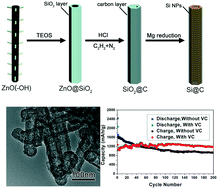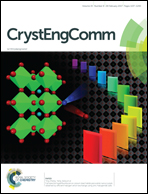Porous Si@C coaxial nanotubes: layer-by-layer assembly on ZnO nanorod templates and application to lithium-ion batteries
Abstract
Porous Si@C coaxial nanotubes were prepared by layer-by-layer assembly on ZnO nanorod templates and subsequent magnesiothermic reaction. ZnO nanorods have been firstly synthesized by a seed-assisted method, which can act as the optimum template to deposit SiO2 and carbon layers, respectively. After the magnesiothermic reaction, the compact SiO2 layer turns into a porous Si layer, leading to the Si@C coaxial nanotubes. The porous Si@C coaxial nanotubes demonstrate excellent cycling stability and high specific capacity as anode materials for lithium-ion batteries, which are extremely better than bare Si nanotubes and bulk Si@C nanocomposites. The outstanding electrochemical performance can be attributed to the fact that the coaxial nanotubular structures can provide enough space to accommodate the large volume changes and give more reaction sites for lithium ions, while the introduction of the carbon layer can enhance the electronic conductivity and stabilize the Si–electrolyte interface and nanotubular structure during the lithiation/delithiation process.



 Please wait while we load your content...
Please wait while we load your content...